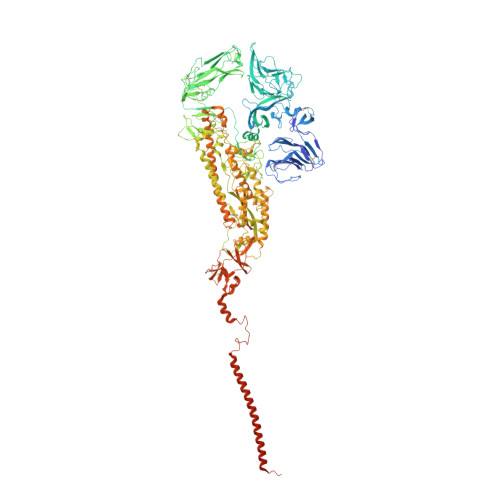Structural insights into the modulation of coronavirus spike tilting and infectivity by hinge glycans.
Chmielewski, D., Wilson, E.A., Pintilie, G., Zhao, P., Chen, M., Schmid, M.F., Simmons, G., Wells, L., Jin, J., Singharoy, A., Chiu, W.(2023) Nat Commun 14: 7175-7175
- PubMed: 37935678
- DOI: https://doi.org/10.1038/s41467-023-42836-9
- Primary Citation of Related Structures:
8FR7 - PubMed Abstract:
Coronavirus spike glycoproteins presented on the virion surface mediate receptor binding, and membrane fusion during virus entry and constitute the primary target for vaccine and drug development. How the structure dynamics of the full-length spikes incorporated in viral lipid envelope correlates with the virus infectivity remains poorly understood. Here we present structures and distributions of native spike conformations on vitrified human coronavirus NL63 (HCoV-NL63) virions without chemical fixation by cryogenic electron tomography (cryoET) and subtomogram averaging, along with site-specific glycan composition and occupancy determined by mass spectrometry. The higher oligomannose glycan shield on HCoV-NL63 spikes than on SARS-CoV-2 spikes correlates with stronger immune evasion of HCoV-NL63. Incorporation of cryoET-derived native spike conformations into all-atom molecular dynamic simulations elucidate the conformational landscape of the glycosylated, full-length spike that reveals a role of hinge glycans in modulating spike bending. We show that glycosylation at N1242 at the upper portion of the stalk is responsible for the extensive orientational freedom of the spike crown. Subsequent infectivity assays implicated involvement of N1242-glyan in virus entry. Our results suggest a potential therapeutic target site for HCoV-NL63.
Organizational Affiliation:
Biophysics Graduate Program, Stanford University, Stanford, CA, 94305, USA.























